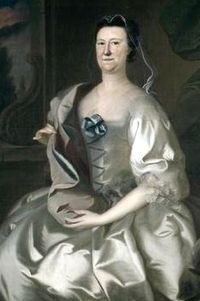Life and career

He seems to have been the son of a painter, and to have had a studio in Boston from 1755 until 1765; among his patrons were many important early American families, including the Apthorps, Amorys, Bulfinches, Lowells, Ewings, Saltonstalls, Winthrops, Winslows and Otises of Boston. Blackburn spent time in Bermuda (1752–1753), Newport (1754), Boston (1755–1758), and Portsmouth (1758–1762). In late 1763 he returned to London and painted portraits in southwestern England, Wales, and Dublin between 1768 and 1777. [2] Approximately one hundred fifty of Blackburn's portraits survive. [2] He excelled at painting textiles (i.e., representing the shimmer of silks, the texture of laces, and the folds of fabrics). [2]
Some of his portraits are in the possession of the public library of Lexington, Massachusetts, and of the Massachusetts Historical Society, but most of them are privately owned and are scattered over the country, the majority being in Boston. One portrait, of Elizabeth Browne Rogers completed in 1761, is part of the permanent American art collection at Reynolda House Museum of American Art located in Winston-Salem, North Carolina.

John Singleton Copley was Blackburn's pupil, and it is said that he finally left his studio in Boston, through jealousy of Copley's superior success. His pictures were long attributed to Copley. [3] [4]
"Now, thanks to evidence found within records held in our collections, we are able to confirm that Joseph Blackburn lived and died in the city of Worcester. He and his family lived in Broad Street in the parish of St. Nicholas. The exact date they moved there is unclear, but he certainly is a resident in 1768. They also leased properties around St. Martins Gate in the city, including The White Horse pub. Joseph inherited the lease for the properties after his father, Joseph Blackburn, gentleman, of Kinfare, (now Kinver), Staffordshire, and possibly his aunt, Henrietta Blackburn of Worcester died in 1759.
"The 1759 will of Henrietta mentions Joseph’s wife Mary and their two daughters, Henrietta and Elizabeth. His daughters both married local men: Henrietta to William Hill and Elizabeth to George Squire, but both women appear to have died without children. ..."
Art historian Lawrence Park authored, and the American Antiquarian Society published, the first biographical and critical study of Blackburn in 1923, restoring this long-overlooked artist to the attention of scholars and connoisseurs. [5]










